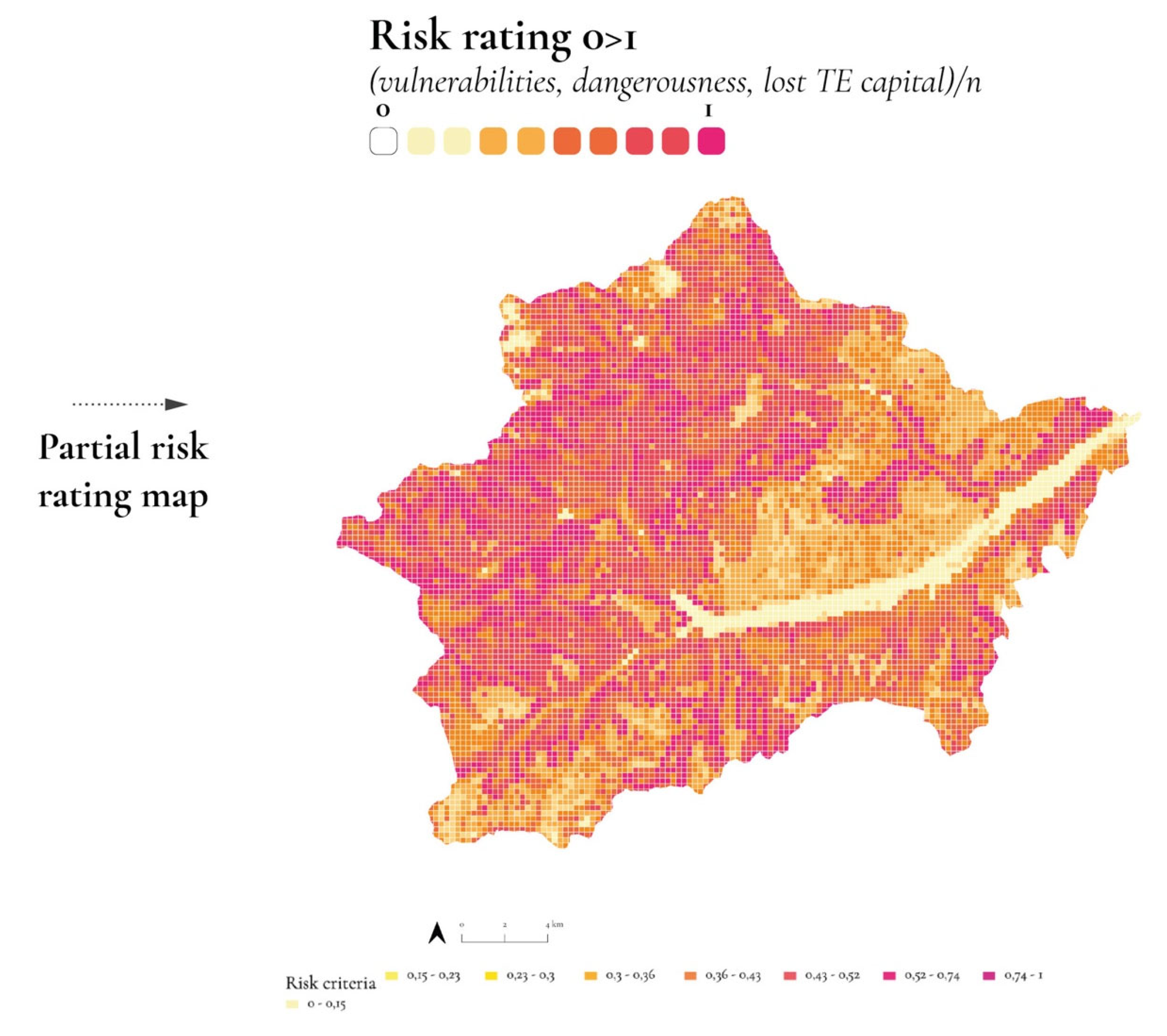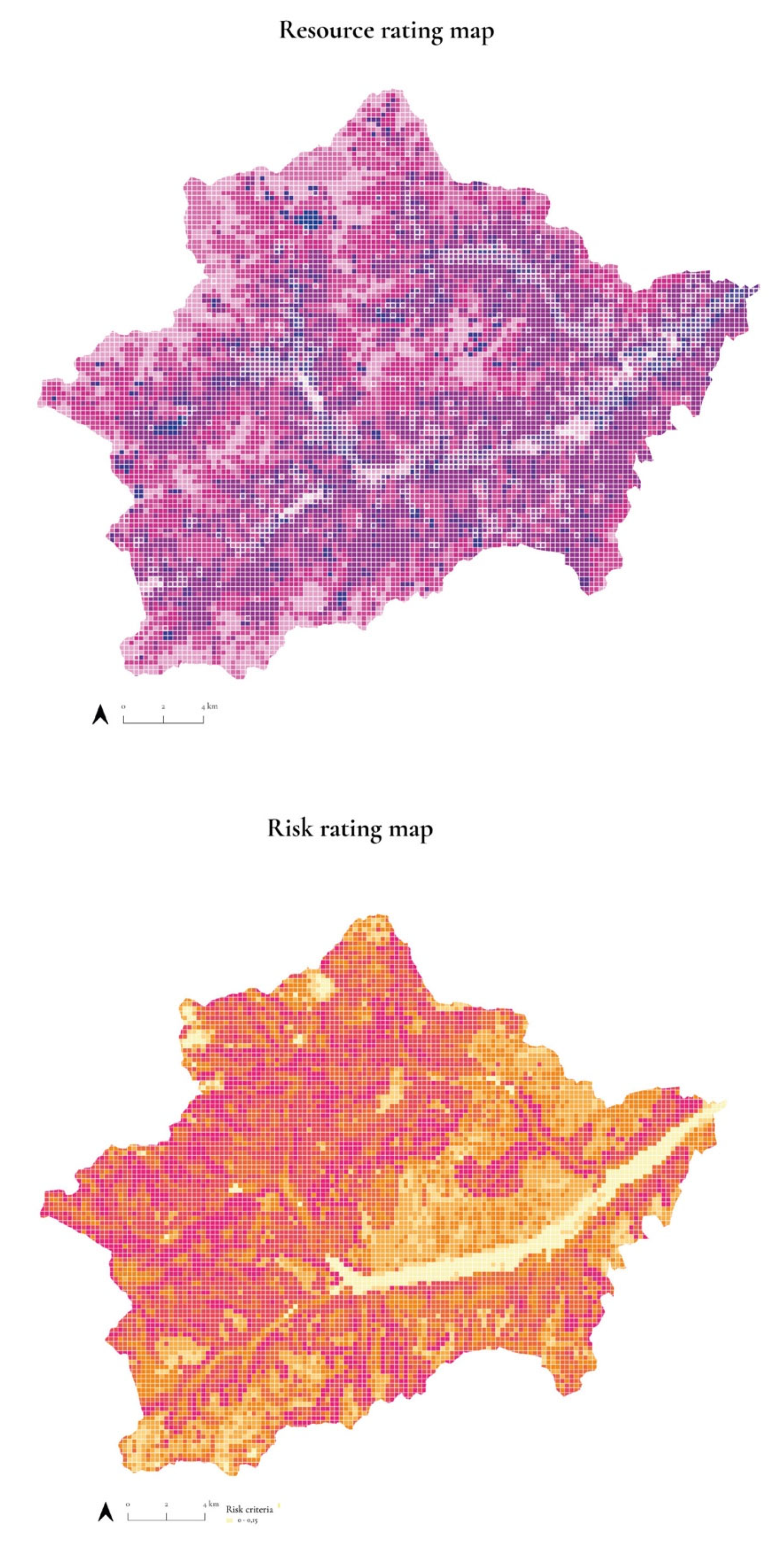“Mapping the Extreme Terres”: A Socio-Ecological Strategy in Response to the Critical Condition of the Italian Hinterland of Val di Sole
Abstract
:1. The Geography of the Crisis in Italian Hinterlands in the Era Post-COVID
2. Italian Inner Areas: How to Design a New “Terre”
2.1. La Terre in Italian Hinterlands
2.2. Extreme Terre: Risk and Resource in Italian Hinterlands
3. Premise: Research Question and Objective
3.1. Research Question and Problem Statement
3.2. Research Aims and Objectives
4. Methodological Approach
4.1. Methods of Investigation: Mapping as a Design Tool
4.1.1. Parameter: La Terre
4.1.2. How to Process Data
- Data reference/Data bibliography: to report and identify data sources.
- Data B4R exploration/new selected data (Figure 3, Figure 4, Figure 5 and Figure 6) or of the selected data: to define whether the reported data have already been previously analysed and catalogued in the PRIN Branding4Resilience [20] research (with which this contribution shares the place chosen as a case study, and the author’s doctoral thesis is related to the PRIN project in the context of Italy’s inland areas), whether they have been selected, or whether they are macro categories in which more data can be reported.
- Semiologique Graphique [27] Type of data: elements/data are represented according to the type of data. Lines, dots, screens, and gradation are used.
- Unit Reference measurement, if applicable: to report the unit of measure in case it is present for quantitative data.
- Selected factors/objectives selected data or a summary of selected data: to report the selected factors’ names.
- Natural/Anthropogenic Ecosystem: this categorisation is chosen and imposed at the beginning of the process. The type of data analysed and its origin, i.e., whether the spatial data reported belong to natural or anthropogenic ecosystems, so we can understand the basis of the risks and resources analysed.
4.1.3. Selection of Spatial Values for Risk and Resource: GIS Assessment Approach
4.1.4. Mapping Application the Extreme Terres: The Tangible Space, Physical Terrain (Mapping)
4.1.5. Mapping Validation the Invisible Potential of Extreme Terres
4.1.6. A Feedback Loop (Multi-Scale)
5. Results of Val di Sole and Val di Rabbi Application Case
5.1. The Val di Sole and Val di Rabbi Inner Territory: A Case Study
5.2. Data Exploration and Parameters Selection, The Val di Sole, Area Interna as Application Case: The Exploration of the Context
5.3. Mapping the Tangible Space of the Val di Sole
5.4. Exploring the Potentials of the Val di Rabbi for Intervention: A Strategic Taxonomy
6. Discussion and Perspectives
7. Conclusions
Author Contributions
Funding
Institutional Review Board Statement
Informed Consent Statement
Data Availability Statement
Acknowledgments
Conflicts of Interest
References
- Moore, J.W. Ecologia-Mondo e Crisi del Capitalismo. La fine Della Natura a Buon Mercato; Avallone, G., Ed.; Ombre Corte: Verona, Italy, 2015. [Google Scholar]
- Olivari, C.; Pasquali, M. (Un)Earth Chile. In New Metropolitan Perspectives; Springer: Berlin/Heidelberg, Germany, 2022; ISBN 978-3-031-06824-9. [Google Scholar]
- Ricci, M. New Paradigms; LISt: Campbell, CA, USA, 2012; ISBN 978-88-95623-53-5. [Google Scholar]
- Barca, F.; Casavola, P.; Lucatelli, S. Materiali Uval; Dipartimento per lo Sviluppo e la Coesione Economica: Rome, Italy, 2014. [Google Scholar]
- De Rossi, A.; Mascino, L. Sull’ Importanza Di Spazio e Territorio Nel Progetto Delle Aree Interne. In Aree Interne e Covid; Fenu, N., Ed.; LetteraVentidue: Siracusa, Italy, 2020; pp. 48–55. ISBN 978-88-6242-476-9. [Google Scholar]
- Tantillo, F. La Mutazione Delle Aree Interne, Da Margini a Nuova Frontiera. In Aree Interne e COVID; Fenu, N., Ed.; LetteraVentidue: Siracusa, Italy, 2020; pp. 34–44. ISBN 978-88-6242-476-9. [Google Scholar]
- Brenner, N.; Elden, S. Stato, Spazio e Territorio. Dialoghi Internazionali 2010, 14, 140–167. [Google Scholar]
- Pileri, P. Ius soli, urbis fortuna. In Suolo. Letture e Responsabilità del Progetto. Ediz. Illustrata; Quaderni del Dottorato; Officina: Rome, Italy, 2017; pp. 52–59. ISBN 978-88-6049-210-4. [Google Scholar]
- Pasquali, M.; Rigo, C. Valorizzare Il Suolo o Abitare La Terre? Una Visione Transcalare per Riconnettere Gli Habitat Marginali Nei Territori Marchigiani e Trentini. In Proceedings of the XXIV Conferenza, Brescia, Italy, 23–24 June 2022. [Google Scholar]
- Brenner, N.; Schmid, C. The ‘Urban Age’ in Question. Int. J. Urban Reg. Res. 2014, 38, 731–755. [Google Scholar] [CrossRef]
- Lanzani, A.; Zanfi, F. L’avvento dell’urbanizzazione diffusa: Crescita accelerata e nuove fragilità. In Riabitare l’Italia; Donzelli: Rome, Italy, 2018; pp. 123–140. [Google Scholar]
- Brenner, N.; Katsikis, N. Operational Landscapes: Hinterlands of the Capitalocene. Archit. Des. 2020, 90, 22–31. [Google Scholar] [CrossRef]
- Pasquali, M. Le Alpi Apuane: Un’antropogeografia tecnologica in risposta alla fragilità delle aree interne della Lunigiana. Polit. Reg. Coesione Aree Interne E Marginali Atti XXIII Conf. Naz. 2021, 3, 62–82. [Google Scholar] [CrossRef]
- Olivari, C.; Pasquali, M. Yuxtaposición Extrema; Maggioli Editore: Rome, Italy, 2019; Volume 24. ISBN 889163 8786.
- Barbera, F.; De Rossi, A. Metromontagna. Un Progetto per Riabitare l’Italia; Donzelli: Rome, Italy, 2021. [Google Scholar]
- Katsikis, N.; Brenner, N. Is the Mediterranean Urban? Walter de Gruyter GmbH: Berlin, Germany, 2013; pp. 428–459. ISBN 978-3-86859-893-3. [Google Scholar]
- Corner, J. The Agency of Mapping: Speculation, Critique and Invention. In Mappings; Critical Views: London, UK, 1999; p. 311. ISBN 1-86189-021-4. [Google Scholar]
- Mapping Parameters Overview. Available online: https://docs.informatica.com/data-integration/data-services/10-2/developer-mapping-guide/mapping-parameters/mapping-parameters-overview.html (accessed on 28 June 2022).
- Scull, P.; Franklin, J.; Chadwick, O.A.; McArthur, D. Predictive Soil Mapping: A Review. Prog. Phys. Geogr. Earth Environ. 2003, 27, 171–197. [Google Scholar] [CrossRef] [Green Version]
- Home Page—Branding4Resilience. Available online: https://www.branding4resilience.it/ (accessed on 28 June 2022).
- Malczewski, J.; Rinner, C. Introduction to GIS-MCDA. In Multicriteria Decision Analysis in Geographic Information Science; Malczewski, J., Rinner, C., Eds.; Advances in Geographic Information Science; Springer: Berlin/Heidelberg, Germany, 2015; pp. 23–54. ISBN 978-3-540-74757-4. [Google Scholar]
- Ferretti, M.; Favargiotti, S.; Lino, B.; Rolando, D. Branding4Resilience. Explorative and collaborative approaches for inner territories. Sustainability 2022, 14, 11235. [Google Scholar]
- Favargiotti, S.; Pasquali, M.; Chioni, C.; Pianegonda, A. Water Resources and Health Tourism in Val di Sole: Key Elements for Innovating with Nature in the Italian Inner Territories. Sustainability 2022, 14, 11294. [Google Scholar] [CrossRef]
- What Is Data Mining? Available online: https://www.techtarget.com/searchbusinessanalytics/definition/data-mining (accessed on 28 June 2022).
- Smallcombe, M. Structured vs. Unstructured Data: 5 Key Differences. Available online: https://www.integrate.io/blog/structured-vs-unstructured-data-key-differences/ (accessed on 28 June 2022).
- ETL vs. ELT: 5 Critical Differences|Integrate.Io. Available online: https://www.integrate.io/blog/etl-vs-elt/ (accessed on 28 June 2022).
- Bertin, J. Semiology of Graphics: Diagrams, Networks, Maps; ESRI Press: Redlands, CA, USA, 1967; ISBN 978-1-58948-261-6. [Google Scholar]
- Parizi, S.M.; Taleai, M.; Sharifi, A. A GIS-Based Multi-Criteria Analysis Framework to Evaluate Urban Physical Resilience against Earthquakes. Sustainability 2022, 14, 5034. [Google Scholar] [CrossRef]
- Greene, R.; Devillers, R.; Luther, J.; Eddy, B. GIS-Based Multiple-Criteria Decision Analysis. Geogr. Compass 2011, 5, 412–432. [Google Scholar] [CrossRef]
- Nimick, S.R. and E. Multi-Criteria Decision Analysis and GIS. Available online: https://storymaps.arcgis.com/stories/b60b7399f6944bca86d1be6616c178cf (accessed on 28 June 2022).
- Minora, F. Terre Comuni Percorsi Inediti Nelle Proprietà Collettive Del Trentino; LaFeltrinelli Internet Bookshop Srl.: Milan, Italy, 2012; ISBN 978-88-904295-9-0. [Google Scholar]
- Gretter, A.; Ciolli, M.; Scolozzi, R. Governing Mountain Landscapes Collectively: Local Responses to Emerging Challenges within a Systems Thinking Perspective. Landsc. Res. 2018, 43, 1117–1130. [Google Scholar] [CrossRef]
- Cash, D.; Adger, W.; Berkes, F.; Garden, P.; Lebel, L.; Olsson, P.; Pritchard, L.; Young, O. Scale and Cross-Scale Dynamics: Governance and Information in Multilevel World. Ecol. Soc. 2006, 11, 8. [Google Scholar] [CrossRef] [Green Version]
- Farina, A. The Cultural Landscape as a Model for the Integration of Ecology and Economics. Bioscience 2000, 50, 313–320. [Google Scholar] [CrossRef]
- Marten, R.; Abrassart, T.; Boano, C. Urban Planning and Natural Hazards Governance. Available online: https://oxfordre.com/naturalhazardscience/view/10.1093/acrefore/9780199389407.001.0001/acrefore-9780199389407-e-347 (accessed on 21 June 2022).

























Publisher’s Note: MDPI stays neutral with regard to jurisdictional claims in published maps and institutional affiliations. |
© 2022 by the authors. Licensee MDPI, Basel, Switzerland. This article is an open access article distributed under the terms and conditions of the Creative Commons Attribution (CC BY) license (https://creativecommons.org/licenses/by/4.0/).
Share and Cite
Pasquali, M.; Marengo, M. “Mapping the Extreme Terres”: A Socio-Ecological Strategy in Response to the Critical Condition of the Italian Hinterland of Val di Sole. Sustainability 2022, 14, 12641. https://doi.org/10.3390/su141912641
Pasquali M, Marengo M. “Mapping the Extreme Terres”: A Socio-Ecological Strategy in Response to the Critical Condition of the Italian Hinterland of Val di Sole. Sustainability. 2022; 14(19):12641. https://doi.org/10.3390/su141912641
Chicago/Turabian StylePasquali, Margherita, and Mathilde Marengo. 2022. "“Mapping the Extreme Terres”: A Socio-Ecological Strategy in Response to the Critical Condition of the Italian Hinterland of Val di Sole" Sustainability 14, no. 19: 12641. https://doi.org/10.3390/su141912641





